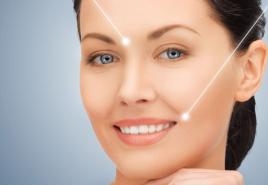Why can't you squint your eyes? Strabismus of one eye appeared what to do
Strabismus occurs quite often. In young children, such a defect can sometimes look touching and funny, but the violation should not be underestimated. At any age, this is an unpleasant pathology that needs to be corrected - both from the point of view of medicine and from the point of view of aesthetics. Although children are most susceptible to the disease, adults are also not protected from it.
In children, strabismus is, of course, easier to correct, especially if it is detected at the very beginning of development, and treatment is started in a timely manner. Strabismus causes a lot of inconvenience to the patient, the squinting eye can completely “fail” over time, not to mention the psychological and aesthetic discomfort. Fortunately, diagnosing strabismus is very simple, and modern medicine provides a whole arsenal of tools for its treatment, up to surgery, if necessary.
What is strabismus
Strabismus (other names - strabismus, heterotropia) is a very common ophthalmic disorder. According to statistics, one child out of fifty suffers from it. associated with inconsistent activity of one or more eye muscles responsible for the movement of the eyeball.
If normally the eyes focus on a certain point, transmitting an image from each eye to the brain, then with strabismus, as a result of muscle weakness, one eye deviates from this point, the image received from one eye does not correspond to the image received from the other. Because of this, the nervous system excludes the picture received from the squinting eye, and no three-dimensional image is created in the brain. As a result, a person sees a flat image, and the eye that squints almost does not participate in the visual process, stops working. Because of this, over time, amblyopia develops, or lazy myopia, “lazy eyes,” as strabismus in children is sometimes called.

The causes of the disease may be different, but in any case, if the diseased eye is not treated, it falls, it is generally excluded from participation in the visual process.
Types of strabismus
The reasons may be different. As for strabismus, ophthalmologists consider a congenital and acquired disease.
By type, strabismus is distinguished into friendly and unfriendly.
Causes of congenital strabismus
In fact, pure congenital strabismus occurs in isolated cases. If strabismus develops in the first six months of life, it is called infantile. In such cases, the causes of the disease are genetic disorders, such as Cruson's syndrome and Down's syndrome; heredity - in this case, strabismus is also diagnosed in relatives of the first and second lines; congenital eye defects, cerebral palsy. Often the disease appears as a result of the consequences of prematurity, the effects of various drugs and drugs on the fetus, and if the mother suffered infectious diseases during pregnancy (measles, cytomegalovirus, SARS, and some others), this can also provoke strabismus in the child.

Causes of Acquired Strabismus
The disease can develop after the first six months of life and even in an adult. In this case, it is called acquired.
The causes of acquired strabismus are many. First of all, the disease is provoked by medium and high degrees of myopia, hyperopia, astigmatism and sudden changes in vision for no apparent reason. Also, strabismus can develop due to various eyes: glaucoma, cataracts, astigmatism and others. In addition to various eye diseases, including retinoblastoma, strabismus after trauma, tumors and other injuries.
Strabismus is the result of muscle paralysis that accompanies certain diseases, such as encephalitis, multiple sclerosis, neurosyphilis, as well as somatic and mental illness. In addition, it is acquired if it is not sufficiently supplied with blood flow, intracranial pressure rises sharply, and pathologies of the brain or spinal cord develop. Strabismus can manifest itself as a complication after influenza, measles, scarlet fever, diphtheria.

It can also cause strabismus in children. Causes of a psychological nature, stressful situations, psychotrauma, nervous overstrain quite often lead to the fact that preschoolers (and sometimes older children and even adults) begin to squint.
Concomitant strabismus
Friendly is a disease in which the angles of strabismus are the same. That is, one eye is mowed, but the angle of deviation of the squinting eye (primary) and the angle of deviation of the healthy (secondary) are equal. Despite the fact that the muscular system of the eyes is developed in different ways, there is no double vision, both eyeballs are fully mobile.
Concomitant strabismus is divided into three groups of visual disorders:
Accommodation.
Non-accommodative.
Partially accommodative.
With accommodative strabismus, the disease is accompanied by any pathology of vision - farsightedness or myopia. This type of strabismus develops between 2 and 4 years of age. Corrected by wearing glasses.

Paralysis of the muscles responsible for eye movement causes non-accommodative strabismus. may lie in problems during fetal development or diseases suffered after birth. This type of strabismus is difficult to identify at the initial stage. It often accompanies cerebral palsy.
- horizontal (when the eyes are directed in different directions - exotropia, or divergent strabismus; when the eyes are directed to the bridge of the nose - isotropia, or convergent strabismus);
- vertical (when the eye squints up - hypertropia, when the eye squints down - hypotropia);
- mixed (when several forms of strabismus are combined).

Glasses do not correct this type of strabismus.
Varieties of non-accommodative strabismus:
- sensory (with a drop in vision in one eye);
- acute (strabismus that suddenly arose after stress, psychotrauma or nervous tension);
- cyclic (strabismus occurs and disappears after a certain period of time, the reason lies in disorders of the central nervous system);
- secondary (strabismus, which changed direction to the opposite after surgical or spectacle correction).
There is also a special kind of non-accommodative strabismus - kurtosis of divergence. In this case, strabismus appears only when a person peers into the distance.

Partial accommodative strabismus combines the symptoms of an accommodative and motor disturbance, such as fluctuations of the eyeballs, which appear involuntarily and regularly. It can be converging (when the eyes are focused on the bridge of the nose) and diverging (the eyes “look” at the temples).
Strabismus can have different degrees of severity:
- strongly rendered has an angle of more than 37 degrees,
- well-visible has an angle of 22-36 degrees,
- average - 11-21 degrees,
- insignificant - 6-10 degrees,
- practically not expressed - the angle is less than 5 degrees.
Unfriendly strabismus
With unfriendly strabismus, the primary and secondary angle of deviation are not the same. The mobility of the eye is limited or absent in one or more directions. Most often, this strabismus also has a paralytic nature of origin, as a non-accommodative species. The causes of this disease are lesions of the oculomotor nerves.
There is also pseudoparalytic strabismus. The causes of visual impairment in this case are developmental anomalies or after surgery, but not nerve damage.
Imaginary strabismus
All types of strabismus that have been described are true. They should not be confused with the imaginary strabismus that occurs in young children. Due to their age, they are often unable to focus on the subject, which creates the appearance that the child is mowing.

However, imaginary temporary strabismus sometimes happens with adults. This usually happens due to alcohol intoxication.
Diagnostics
Even if it seems that strabismus is almost imperceptible or harmless, you should not delay treatment. This is not a cosmetic defect at all, so it requires immediate attention as soon as it is discovered. If strabismus is not corrected, the eye may lose the ability to see.
The first symptoms of strabismus:
- deviation of one or both eyes towards the nose (convergent strabismus) or to the side (divergent strabismus),
- the inability to focus on the subject (the so-called floating gaze).
In this case, you need to take into account many details so as not to confuse the disease with an imaginary one. For strabismus, you can take a special or their specific location, characteristic of a particular child. Here it is important to distinguish the actual symptoms of strabismus from imaginary signs. These physiological signs most often disappear on their own with age. A floating gaze can also be found in infants up to six months old, who cannot yet focus on an object. This also goes away with age. There are many parents who began to panic when they suspected strabismus in children under one year old, their worries were dispelled either by specialists or by the disappearance of symptoms at a later age.
Often, strabismus is noticed by the parents themselves and they turn to an ophthalmologist. This is the kind of disease that you can actually diagnose on your own, without the help of a specialist.
Also, the disease can be detected during a routine examination of the child. The eye doctor performs diagnostics of the entire visual apparatus, including using a computer, conducts tests confirming the absence of volumetric vision and the fact that the child has strabismus. The causes of the disease must be found out in order to prescribe a treatment suitable for this type of problem.

The doctor selects glasses or lenses, prescribes hardware treatment and, if necessary, medications. In difficult cases, he can refer you to an ophthalmological clinic for surgery.
If you start treatment at an early stage of development, in most cases it is possible to completely get rid of the disease.

Non-drug treatment
Strabismus can sometimes be corrected with glasses or contact lenses. This method is indicated for accommodative and partially accommodative strabismus.
With partially accommodative strabismus, Fresnel prisms, complex composite lenses, are glued onto the lenses of the glasses.
The pleoptics method, that is, occlusion treatment, is also successfully used. In this case, a bandage is put on the healthy eye or an eye patch is glued. Treatment should last at least 4 months and is indicated mainly in the treatment of childhood strabismus. With this method, it is necessary to constantly monitor the visual acuity of a healthy eye that is subjected to permanent gluing. To make the treatment more effective, pleoptics is combined with hardware correction, which includes laser therapy, amblyocor, electrical stimulation and other methods.

Medical and hardware treatment
The drugs are prescribed in conjunction with apparatus treatment and exercises for the eyes and either relax the muscles and dull vision, like atropine, or, like pilocarpine, prevent pupillary constriction. The essence of the treatment is to increase the load on the eye and stimulate its active work.
The hardware is also effective in treating the disease. Devices such as monobinoscope and synoptophore are used. The first irritates the retina with light rays and thereby fights amblyopia (low vision) and double vision. The second is used for sensory strabismus if the angle of strabismus is large enough.
Patients are also shown orthopto-diplopticheskoe treatment, which consists in training exercises on the apparatus. Such treatment is aimed at the development of binocular vision.
Surgery
In some cases, strabismus is recommended surgical intervention. Thanks to him, the muscle that is responsible for the movement of the eyeball is strengthened or weakened. Strabismus surgery is used if complex treatment has not helped. It is also indicated for paralytic and non-accommodative forms.
With strongly visualized strabismus, several operations can be performed on each eye with a break of at least six months.

In the case of strabismus, two types of operations are performed: resection, which shortens the length of the eye muscle, and recession, which moves the eye muscle. The choice of the nature of the operation depends on the type of strabismus and its angle. A combination intervention can also be performed. Operations are performed both under general and local anesthesia.
It should be replaced that up to 3-4 years of age, strabismus is not surgically corrected. It is necessary to wait until binocular vision is formed, that is, the ability to see an image of an object with both eyes. At an earlier age, surgical intervention is possible only if there is a congenital strabismus with a significant angle of deviation. Such operations can only be carried out by an eye doctor - a surgeon.
After the operation, the treatment should be continued by some other of the above methods in order to restore and strengthen binocular vision.
Strabismus is considered to be a childhood pathology, but in adults it is a much more significant problem, as it can be a symptom of a dangerous disease. In addition, strabismus in adults is more difficult to treat, and mainly by surgical methods.
What ordinary people call strabismus is called strabismus in medical parlance. The essence of this pathological condition is the violation of friendly eye movement. Strabismus is not only a cosmetic defect, the owners of this disease lose their binocular vision, that is, they cannot correctly determine the relative position of objects in space.
It is generally accepted that strabismus is a childhood disease, and this statement is partly true. In more than 70% of patients, this problem is detected in childhood. However, they may suffer strabismus and adults, and in this category of patients it is treated much more difficult.
Strabismus classification
According to the timing of occurrence and persistence of manifestations:
- congenital and acquired
- Periodic and permanent.
According to the involvement of the eyes in the process:
- Monolateral or unilateral mows only one eye.
- Alternating, or intermittent - alternately mows one or the other eye.
By the way, both eyes cannot squint at the same time. One of them is always looking in the right direction. There is an imaginary strabismus, in which both eyes seem to squint. At the same time, the friendliness of the movement of the eyeballs is not disturbed, and the cosmetic defect is due to congenital structural features of the skull or orbits.
By severity:
- Hidden - the absence of binocular vision, is detected with the help of special equipment.
- Compensated - diagnosed using special ophthalmological tests.
- Subcompensated - by an effort of will, you can return the “gone to the side” eye to its place.
- Decompensated - uncontrollable.
In the direction of displacement of the axis of the squinting eye:
- Converging (converging) - the eye "looks" towards the bridge of the nose.
- Divergent (divergent) - the eye is shifted towards the temple.
It is also possible to shift the squinting eye up or down.
Causes of strabismus
According to the etiology, strabismus can be classified into 2 groups.
1. Friendly - mows then one eye, then the second. This pathology arises due to the fact that the “quality” of the image that one of the eyes supplies to the brain is very different from the other. At the same time, the brain, as it were, turns off the picture from one eye, vision ceases to be stereoscopic, and the “turned off” eye begins to mow.
The main cause of concomitant strabismus is accommodation disorders - myopia (myopia), farsightedness (hypermetropia) and astigmatism. Moreover, with myopia, divergent strabismus most often occurs, and with hypermetropia, convergent strabismus occurs. This type of concomitant strabismus is called accommodative.
Also, this type of strabismus can be caused by any other pathologies that lead to a significant difference in visual acuity between the eyes: cataract, leukoma (corneal cataract), retinal dystrophy or detachment, macular degeneration, vitreous hemorrhage, etc. This type of concomitant strabismus is called non-accommodative.
With concomitant strabismus, the range of motion of the eyeballs is not disturbed, there is no double vision (diplopia).
2. Paralytic - occurs as a result of damage or paralysis of one of the oculomotor muscles.
Causes of strabismus in this case it could be:
- injuries or diseases of the eye muscles and orbit;
- brain pathology - strokes, craniocerebral injuries, meningitis, encephalitis, tumors;
- pathology of the oculomotor nerves - neuritis, tumors, complications of infections of the upper respiratory tract (otitis media, sinusitis).
With paralytic strabismus, the range of motion of the affected eye is reduced, diplopia is present.
Diagnostics
Pronounced strabismus is always noticeable to the patient himself when looking in the mirror, as well as to his surroundings. Don't think it will go away on its own. Rhetorical question: " Mows one eye what to do?" - has only one answer - immediately contact an ophthalmologist. The sooner treatment is started, the higher the chances of success.
Latent strabismus is not felt by the patient himself, but it can be detected with the help of special ophthalmological tests. Therefore, people at risk (having a pronounced difference in visual acuity between the eyes) should regularly undergo an in-depth examination by an ophthalmologist.
Paralytic strabismus in adults, as already mentioned, can be a symptom or complication of other diseases. Therefore, if you suddenly have double vision and severe strabismus, you should urgently contact a neurologist, as this may be a sign of nerve inflammation, a brain tumor, a stroke, or the spread of an infection from the middle ear to the cranial cavity.
Treatment of strabismus in adults
1. With concomitant strabismus, the goal of treatment is to restore normal visual acuity.
Accommodation disorders are corrected with glasses, contact lenses or laser correction. Contact lenses in this case are most preferred. With severe myopia or farsightedness, the lenses of the glasses reduce or increase the size of the image on the retina. Accordingly, if the optical power of the lenses is different, then the image on the retinas of the eyes is of different sizes, which misleads the brain and it is forced to use the image of only one eye, while the second begins to mow.
Non-accommodative disorders (cataracts, cataracts, retinal detachment, etc.) can be surgically treated. In case of cataract, lens prosthesis is performed, corneal cataract is corrected by its transplantation from a donor, hemorrhages in the vitreous body can be eliminated surgically. The situation is more complicated with pathologies of the eye vessels or retina. But even here, ophthalmology has a number of technical innovations, such as laser correction. People predisposed to eye pathologies (hypertension, diabetes mellitus) require regular courses of drug treatment aimed at preventing visual impairment.
2. With paralytic strabismus in adults capabilities treatment extremely limited. If the cause, mainly neurological, cannot be eliminated, an operation is performed to eliminate the cosmetic defect. Binocular vision is not restored.
Recommended by some "folk healers" or private ophthalmological clinics, eye exercises and hardware methods of eye training can correct strabismus in children and adolescents under 14 years of age. In adults, they are ineffective.
Very often we mistakenly believe that the health that we have at a young age will remain forever. And therefore we absolutely forget about various measures for the prevention of certain diseases. And when the moment of illness comes, with great excitement and fear we go to the doctor for help. Let's try to understand one of the problems that can arise at different ages and which concerns a vital organ that helps in the perception of the world - our eyes. Why do some conditions arise, how to cope and what to do so that in the future a small ailment does not turn into a big problem?
So, let's see why he began to squint his eyes. In general, what is strabismus, how dangerous is it and what to do in certain cases? To do this, consider the possible reasons, starting from the first days of human life.
Newborn
This is a period in the life of a new person, which lasts exactly one month. When a child is born, he may well have a similar problem. Some children squint the left eye, some - the right. What to do in this case?
So, the child mows one eye. How to be in this case? The answer is simple - no way. In the first three days after birth, most babies experience postpartum strabismus. The fact is that the eye muscles in a baby are underdeveloped at birth. Therefore, such a state is quite acceptable. But usually within three days the position of the eyeballs is gradually aligned. Neonatologists usually warn of such a manifestation - you should not be afraid. Moreover, just these first three days of life, even full-fledged healthy children are under the supervision of doctors.

It turns out that the eyes of newborns mow for a fairly short period of time. You need to worry when a pronounced strabismus does not go away by the 3rd day or does not recover by the month of life. Every person is born with an individual body. And someone needs a day to recover, and someone a few weeks. Therefore, this state must be observed. But usually doctors can immediately determine whether the problem is significant, and accordingly, take action. Thanks to this, it is possible to correct the situation before the first year of the child.
From one year to three
Another question is if the eyes began to squint in the period from a year or even six months to three years. In this case, there may already be a more serious problem that requires an immediate response. Eyeballs can squint for a variety of reasons. Starting from the lack of vitamins for the full functioning of the eye muscles, ending with congenital eye diseases, such as astigmatism, myopia, etc.
Therefore, if the eyes of a newborn are squinted, observation is important, but in infants under three years of age, medical assistance is already needed. Most often, the disease manifests itself gradually. At first, the right eye or left eye slightly mows, and over time, the picture worsens.

A mandatory visit to an ophthalmologist is the beginning of the recovery phase. In some cases, corrective glasses are enough, in others - hardware techniques. Most often, surgical treatment is not performed at this age, since the muscles are not yet fully developed, which means that there is a chance that with the use of special training they will become stronger, the position of the eyes will be restored.
It is worth touching on the topic of types of strabismus here. After all, it is divided into: congenital and acquired. Congenital most often manifests itself precisely during the first three years of life. Moreover, it may not appear immediately in the advanced stage. It may be that sometimes the eye squints, and sometimes not - depending on the angle of view. But this is already an important symptom with which it is necessary to show a specialist.
school period
We skipped the age from 3 to 7 years, because most often congenital strabismus can manifest itself before 3 years, and acquired, due to eye strain and stress, after 7 years. This is because, going to school, the child plunges into an unfamiliar environment, which in itself is stressful. Changes in the daily routine, nutrition, sleep. At the same time, growing visual loads appear. And this is without taking into account the constant flow of information and the use of various mobile and multimedia devices.

As a result, vision may deteriorate sharply, and as a result, it squints the eye. Therefore, in this period of life, moderate exercise, sufficient oxygen nutrition, which, of course, the child receives on the street, are important. Therefore, walks for schoolchildren are no less important than for newborns. Vitamin and mineral deficiencies can also affect.
adult age
Alas, after the age of 18, rapidly developing strabismus is a dangerous problem. In general, the correction of strabismus can only be up to 25 years. After this age, most of the treatment is surgical. Therefore, if the eyes began to squint already in the adult period, an appeal to a specialist should be without delay and observation, otherwise the picture may worsen further.
Very often in adulthood, strabismus is acquired due to serious diseases of the brain or its injuries. In this case, there will be a special approach, so there should not be any self-treatment.

So, take care of honor from a young age ... The same expression can be attributed to health. Because a person in the process of life is influenced by many factors that gradually weaken the resistance of the body and its work. Therefore, what to do if it squints the eye? Contact a doctor! What can be done to prevent the problem? Lead the right lifestyle, namely: more fresh air, vitamins for general strengthening of the entire body system, as well as vitamins for the eyes. Balanced diet and moderate exercise.
This is one of the few eye diseases that can be recognized even without the help of a specialist. Strabismus- this is a condition that is characterized by a deviation of one or both eyes from the central axis, that is, a person's eyes do not look in one direction, as expected, but in different directions. And as a result, the gaze cannot focus on the subject under consideration.
Most often, strabismus develops in children aged 2-3 years during the formation of friendly work of both eyes. According to medical statistics, every 50th child suffers from some degree of strabismus.
Strabismus can appear as a result of: injuries and infectious diseases of the brain; inflammatory, vascular or tumoral changes in the eye muscles; incorrectly or untimely compensated myopia, hyperopia or astigmatism; congenital diseases or birth injuries; increased mental and physical stress; non-observance of visual loads in children.
There are two forms of strabismus - friendly and paralytic.
In the case of concomitant strabismus, it mows either the left or the right eye, while the magnitude of the deviation from the direct position is approximately the same. This type of strabismus is most often associated with the peculiarities of the structure of the eye, inherited and manifests itself mainly in children. Paralytic strabismus occurs either due to damage to the glaeomotor muscles, or as a result of a disease of the visual-nerve pathways. At the same time, one (healthy) eye mows.
When a person examines an object, his diseased eye moves poorly or does not move at all, and the healthy one has to deviate to a larger angle. Strabismus can be: converging(often combined with farsightedness) when one of the eyes deviates towards the nose; divergent(often combined with myopia), when one of the eyes deviates to the temple; vertical when the eye squints up or down.
Most likely, others will be the first to notice strabismus. For example, a child will be teased by peers in kindergarten or at school (“one eye is on the Caucasus, and the other is on Arzamas”). An adult will be hinted that something is wrong with his eyes, constantly or periodically their position becomes asymmetrical. At the same time, the patient himself begins to be disturbed by double vision, dizziness and headaches. Instead of a three-dimensional image, he sees a flat one, notices a decrease in visual acuity in the squinting eye.
Strabismus that develops in childhood can affect the formation of the child's psyche. In children, the perception of the world around is disturbed, physical and mental development may slow down.
A common complication of strabismus is amblyopia("lazy eye") - a sharp drop in vision in the squinting eye as a result of insufficient visual load on the muscles of the eye. The diagnosis of strabismus is established only by an ophthalmologist after a thorough examination and clarification of the possible causes of strabismus. The doctor will check visual acuity using special tables, determine the angle of strabismus, evaluate the friendly work of both eyes using special mirrors.
It is desirable to start treatment of strabismus as early as possible, by itself it cannot disappear with age. Treatment of strabismus is long (on average it takes 2-3 years), requires careful observance of all doctor's prescriptions and constant monitoring. The fight against strabismus begins with the correction of existing myopia, hyperopia, astigmatism. Wearing spectacles starts at a very young age, wear them constantly and for a long time until the symptoms of strabismus decrease. Another important part of the treatment is the performance of special exercises aimed at creating a visual load on the weakened muscles of the squinting eye.
 With the development of complications of amblyopia, it may be necessary to wear glasses with one of the glasses sealed - thus, for the worse seeing eye, conditions are created for its constant load and, accordingly, training of weakened eye muscles.
With the development of complications of amblyopia, it may be necessary to wear glasses with one of the glasses sealed - thus, for the worse seeing eye, conditions are created for its constant load and, accordingly, training of weakened eye muscles.
Such treatment is carried out for a long time and requires constant monitoring of vision for the timely termination of treatment. If glasses and special exercises do not help, or in cases of paralytic strabismus, the patient is referred for surgery. In children, it is most often performed at the age of 3-6 years. Up to 14 years of age, operations are performed under general anesthesia, after 14 under local anesthesia. Recovery after surgery takes an average of ten days. After the operation, it is necessary to continue to perform special exercises to train the eye muscles and the constant supervision of an ophthalmologist.
Even from early childhood, it is necessary to properly give children visual loads: you can’t hang toys too close to the child’s eyes, you need to monitor his posture, follow the rules for alternating the learning process: the physical and mental stages of personality formation.
Before using the drugs listed on the site, consult your doctor.
Strabismus can develop not only in children, but also in adults. This pathology can also be found under the name strabismus or heterotropia.
In people with strabismus, the eyes cannot be focused in one direction, so the patient is unable to direct both organs of vision at once to one object. One eye will be turned to one side, up or down. For some people, strabismus is a temporary phenomenon and occurs only against the background of illness or stress. Others have it permanently.
If timely treatment is not started, then strabismus will cause a decrease in vision. This problem develops in 5% of patients with heterotropia.

is a disease in which there is a violation of the visual axis of the eye. The gaze cannot be focused at one point, so a person perceives the same object in different ways.
The brain receives the wrong signal and processes it in the same way. To protect itself, the central nervous system excludes the diseased eye from its "zone of responsibility." Therefore, it is wrong to consider strabismus solely as a defect in appearance. This is a serious disease that needs treatment.
Problems it can cause:
The inability to correctly estimate the size and distance to the object.
Disturbed perception of perspective.
Deterioration of coordination. If it develops in a child, then it will be difficult for him to maintain balance, he will often fall. Small children with strabismus may refuse to stand up at all.
Reduced vision, incorrect processing by the brain of information received from the visual analyzer.
If a person has a slight strabismus, then it is most often discovered by accident. Dealing with such a violation is not difficult. With severe strabismus, treatment is not always effective.
Adults rarely visit an ophthalmologist. Even if their eyesight begins to deteriorate, they attribute this to the natural aging of the body and are in no hurry to solve the problem. You shouldn't do it this way. It is important to consult a doctor on time. The sooner strabismus treatment is started, the better the prognosis.
Causes of strabismus in adults

Strabismus can be congenital or acquired. There is also a moving strabismus.
The causes that cause acquired strabismus can be identified as follows:
-
Degenerative processes of the macula.
Retinal detachment.
TBI leading to cranial nerve palsy.
Benign and malignant tumors.
Infection with viruses and bacteria, leading to the development of neuroinfection. Strabismus can occur with meningitis and encephalitis.
Violation of the integrity of the bottom or wall of the orbit.
Complications of diseases of the respiratory system.
Congenital strabismus can occur for the following reasons:
Violations of intrauterine development.
Genetic anomalies.
Early onset of labor.
Dropsy of the brain.
congenital cataract.

There are several classifications of strabismus, each of which is based on a certain criterion.
Depending on the time of development of the violation, there are:
Strabismus is congenital. It is diagnosed in a child in the maternity hospital. Doctors call this pathology infantile heterotropia. It is rarely diagnosed.
Acquired strabismus. A violation develops due to an infection, after serious illness, against the background of an injury with damage to the spinal cord or brain.
Depending on the frequency of manifestation of strabismus, there are 2 of its forms:
Temporary.
Permanent.
Depending on the involvement of the organs of vision in the pathological process, strabismus can be:
Unilateral.
Alternating.
Depending on the severity of the violation, there are:
Hidden strabismus. It can be diagnosed only in the ophthalmologist's office using special equipment.
Compensated strabismus. It can be detected only after special tests.
Subcompensated strabismus. A person can partially control the squinting eye.
Decompensated strabismus. The movements of the eyeball are uncontrollable.
Depending on the cause of the occurrence, there are such types of violations as:
Concomitant strabismus. This disorder is most often diagnosed in childhood. The eyeball is displaced from time to time, or strabismus is present on an ongoing basis. Most often squints the eye towards the bridge of the nose.
Paralytic strabismus. It develops mainly in old age. The cause is a violation in the work of the oculomotor muscles.
Depending on the direction of the eyeball, there are such types of strabismus as:
Esotropia. In this type of strabismus, the pupil is closer to the bridge of the nose (convergent strabismus).
Hypertropia. The pupil of the patient goes up, can roll under the eyelid (upper vertical strabismus).
Exotropia. The pupil of a person tends to the bridge of the nose. This is the so-called divergent strabismus.
Hypotropia. With this type of violation, the pupil rolls under the lower eyelid (vertical lower strabismus).

Depending on the mechanism of development of the disorder, there are 3 forms of strabismus:
Accommodative strabismus, which is divided into refractive and non-refractive. With refractive strabismus, the patient develops severe ametropia. Treatment of accommodative strabismus involves wearing glasses.
Non-accommodative strabismus. A person has abnormal refraction and ametropia. The severity of the impairment varies widely. It will not be possible to get rid of the pathology with the help of glasses. Non-accommodative strabismus develops due to unsuccessful surgical intervention on the organs of vision, in the presence of a thorn on the cornea, with pathologies of the optic nerve, or with congenital cataracts.
Partially accommodative strabismus. It is possible to cope with the violation with the help of corrective glasses, but the doctor will not guarantee the patient a full restoration of vision.
Symptoms of strabismus in adults

Most often, the symptoms of strabismus are obvious even for people who do not have a medical education.
Among them are:







